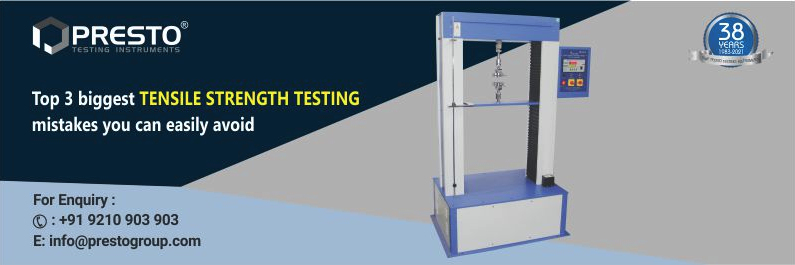

11-10-2021
Tensile strength is one of the most important factors when it comes to determining whether a material can be used for a certain application or not. It basically indicates the ability of a material to resist a force that will tend to move it apart.
However, while conducting the tensile test with the help of a tensile strength tester, the quality engineer will make several testing mistakes that should be avoided. These mistakes would lead to inaccurate testing results. Therefore, in this blog, we have listed the 3 common tensile strength test mistakes and how you can easily avoid them.
Avoid these mistakes before you start your next tensile test
Tensile testing is an important part of the manufacturing process. It’s used to determine the strength and quality of materials if they can withstand the external force or not. With the help of this blog, you will be able to learn how to avoid these common tensile strength testing mistakes so that you can perform accurate tests on all of your materials without risking injury or product damage.
We will also list some simple steps for proper tensile strength testing to ensure accurate results every time! So, let us get started.
Tensile strength testing is not a simple task. It involves several factors that need to be taken into consideration in order to get accurate results. Most people don't know what they are doing when it comes to tensile strength testing and end up making costly mistakes that can ruin their product or even hurt someone using the product. Using an accredited tensile tester will ensure you have accurate results with no risk of failure or injury from incorrect usage. We at Presto will provide you with high-quality certified testing equipment that is made in accordance with ASTM guidelines for accuracy and precision that will help to give accurate testing results whenever you conduct any test. Our certified testers come with user guides, training videos, and 24/7 support so you can test safely without worrying about any errors.
Another most common mistake that you should avoid is the wrong load cell capacity. You should choose the right testing instrument and perform this test by determining its load cell capacity. For instance, if you select our Tensile Test Machine (Cap-10000 kgf.) Digital Model no. ADTTM 10000 then you will get the load capacity of 10000 kgf with the test speed range with speed drive to be 50 - 500mm/min. With an S-type Load Cell sensor, you will be able to determine the accurate tensile value during the test. When you use the load cell at the lower end of its capacity, then you are likely to produce a large error relative to its magnitude of force being measured. Therefore, you should make use of a significant load cell that should not render the tensile strength measurement. You can also choose different models of Tensile strength tester from Presto with different load cell capacities like 1000 kgf, 100 kgf, 2500 kgf, 250 kgf, 5000, 500, and 50 kgf value. We will also guide you well regarding which load cell capacity tensile machine will suit best for your product and how you can avoid flaws while testing.
This is one of the most common mistakes, most quality engineers do while testing the product with a tensile strength tester. If you are measuring the tensile strength of the specimen with low forces then a small fraction of the specimen will become a concern. Therefore, the Presto tensile strength tester Digital Model will come with no slippage grips for firm clamping of the test specimen. You will also find safety features like limit switches protection for the protection of grips and the machine. You should determine the grip weight that it should be close to the capacity of the load cell.
Conclusion
Tensile strength testing is a common practice in the engineering industry. If you’re new to this concept, or have been doing it for years and want to ensure your process is as effective as possible, here are three of the most frequent mistakes that can be easily avoided. No matter what stage of tensile strength test development you may be at right now, these errors will help guide you on how to work smarter instead of harder—and produce more accurate results! To get even more assistance from our team regarding this product, you can call us at +91 9210903903 or emailing us at info@prestogroup.com.
Related Blogs

UV Chamber simulates sunlight to test material durability against UV rays, helping ensure long-term quality and resistance to environmental damage.

Salt spray test checks corrosion resistance of materials using a salt spray chamber. Essential for quality control in coatings, metals, and finishes.

Hot Air Oven uses dry heat for sterilizing glassware and metal tools, while an Autoclave uses steam under pressure—ideal for liquids and medical items.